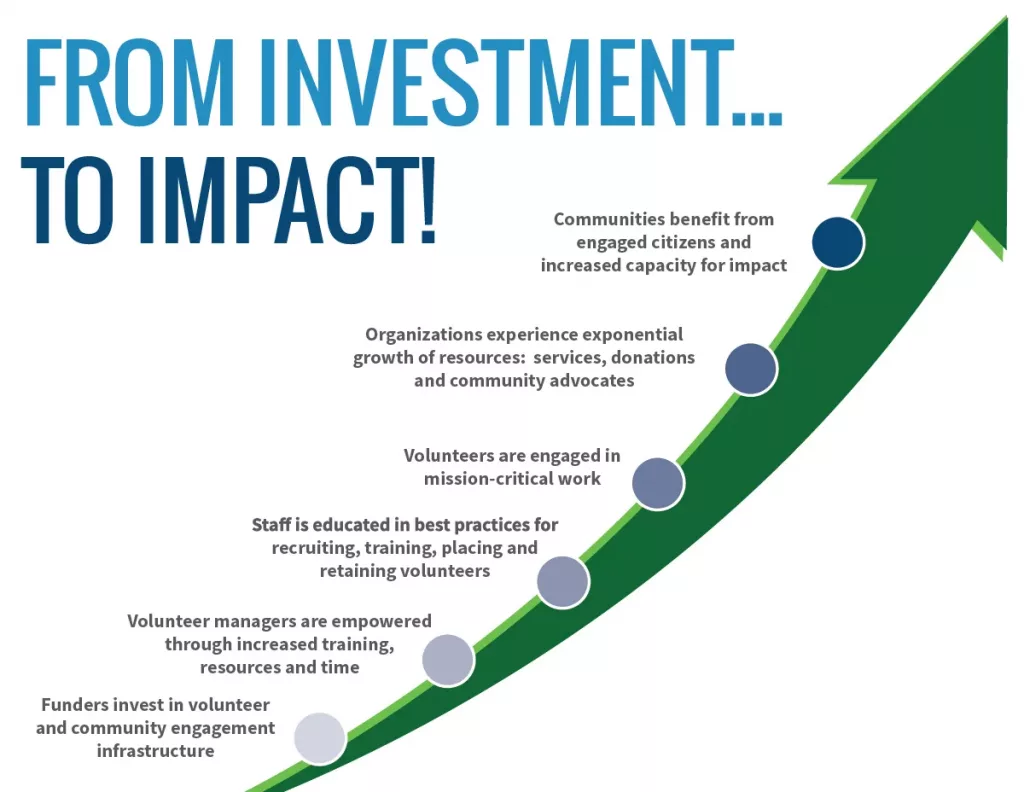
Foundations are always looking for leverage. Where and how can we invest our limited assets to get the best returns? Will our grantees survive these times of shrinking resources and growing needs? As investors in the nonprofit sector who look for innovative ways to maximize our efforts, we must challenge ourselves to better support and build organizational capacity.
A logical and often overlooked solution: supporting effective volunteer engagement and the infrastructure that sustains it.
Building organizational capacity
When forming our family foundation, we agreed that helping organizations engage volunteers would increase their ability to accomplish their missions and be sustainable. This strategy has provided a big return on our investment.
In 2011, the Pikes Peak Volunteer Engagement Initiative sought to increase the effectiveness of nonprofit volunteer engagement strategies in the Colorado Springs area. The goal was to enhance these organizations’ capacity to fulfill their missions and meet community needs. The Leighty Foundation funded and led a five-year initiative to increase the capacity of nonprofit organizations in the region. We invested in individual organizations in the community through volunteer impact grants, and we had experts provide training and support.
In its first phase, the initiative convened and connected board and executive leaders, staff members and volunteers to identify needs and issues related to volunteer engagement. We also fostered peer exchanges and learning through a community-wide symposium on volunteer engagement, seminars and reflection gatherings.
Phase II invested even more deeply in local organizations that demonstrated readiness to take their engagement practices to a new level. This phase kicked off with a half-day training on volunteer engagement trends and innovations, attended by 24 organizations. Participants were then invited to apply to be part of Phase II, which included in-depth training and support. Nine diverse organizations were selected and encouraged to identify a strategy for accomplishing their mission through engaging volunteers. Each benefited from an orientation, a pre-project assessment and a full-day summit on volunteer engagement. This was followed by seven months of team coaching as they implemented volunteer engagement innovations and infrastructure improvements.
Post-project evaluations demonstrated that all organizations measurably enhanced their volunteer engagement practices, learned new skills, developed new programs, engaged new volunteer leaders and increased their capacity to deliver services.

Volunteer engagement as a core strategy
Current research supports our approach. It demonstrates a strong connection between organizations that operate with volunteer engagement as a core strategy for mission accomplishment, and the overall health and effectiveness of the organization. For example:
- Organizations that fundamentally leverage volunteers and their skills to accomplish their missions are significantly more adaptable, sustainable and capable of going to scale. [1]
- Organizations that effectively engage volunteers are as equally successful in accomplishing their mission as their peers without volunteers, but at almost half the median budget. [2]
- High net worth volunteers give up to ten times more money than non-volunteers, and most donate to the organizations in which they are involved. [3]
- Effective volunteer engagement has been shown in some cases to reap up to a $6 return on every dollar invested when considering the financial value of volunteer involvement. [4]
We as funders need to seize this unique opportunity to build nonprofit capacity and sustain and promote more effective volunteer involvement. Here are four actions YOU can take to help make this goal a reality:
- Facilitate or convene dialogue with other funders and nonprofits in the community on volunteer engagement strategies and best practices. Explore how you might enhance the volunteer engagement strategies of your grantees.
- Ask for feedback regarding volunteer successes and challenges in your grant application and evaluation forms.
- Welcome a budget line item to fund a volunteer engagement professional, volunteer resources management technology and software, training and coaching for staff on volunteer engagement, and other vital volunteer resources.
- Support existing professional development, training, and networking opportunities for executive directors, managers of volunteer resources, and other organizational staff and volunteer leaders; provide scholarships to enable those professionals and volunteer leaders to participate.
Volunteers are a vastly underused, yet they’re a virtually unlimited renewable resource. The need is urgent, the timing is critical, and the support is necessary.
Jane Leighty Justis is president of The Leighty Foundation, a small family foundation committed to investing its limited resources in ways that create the greatest impact and ensure the most valuable return on investment. Jane also serves as program director working with other funders and nonprofit organizations in the area of capacity building for volunteer engagement. Jane spent 20 years consulting in the field of volunteer engagement, and, in addition to her current role with the foundation, she is also a nationally recognized speaker on family philanthropy.
